By Judy Winberg, Member, Holy Blossom Temple Archives Committee
During the Yom Kippur Yizkor services, we will read:
“…We remember too, the men and women who but yesterday were part of our sacred congregation and our community. … … Their memories will forever be a blessing.”
And so, our teachings guided us as we tried to unravel a mystery that found its way to our Archives committee almost one year ago. Neighbours of the Temple’s first cemetery on Pape Avenue were excavating their backyard when they found a headstone, believed to come from a grave there.
The time-weathered stone, about 15 inches square and weighing 50 lbs., had faded Hebrew lettering. The stone itself was intact but far from its original location. The headstone was delivered to the Temple, and the effort to solve the mystery began.
To whom did this headstone belong? When did the burial take place? How did it come to be buried in a backyard on Austin Avenue? And what, according to halacha (Jewish law and tradition) should we do now that it was in our possession?
Efforts to learn more about the original location of the grave and who may have been buried there were in vain. The stone was so eroded that, despite exacting best archival techniques, the wording could not be deciphered. We reached out to the past Chair of the Temple’s Cemetery Committee and the Ontario Jewish Archives; we consulted our clergy and sought legal counsel regarding the Ontario Cemeteries Act and Bereavement Authority of Ontario. Sadly, there was little to guide us. While our tradition teaches that we are to honour and respect the dead, the law is silent on any protocol for returning a headstone to its original location.
Still, during our investigation, we unearthed (pun intended) a treasure – written records of the burials as Pape Avenue from a long-lost map marking the names and locations of 200+ graves. Many graves were assigned to children and many of those were located around the cemetery’s perimeter. It may be that the headstone belonged to a child; short life expectancy was not uncommon in the late 19th century.
We felt that the most appropriate action was to return the headstone to its original resting place.
This summer, members of the Archives Committee conducted a historical walking tour of the Pape Avenue Cemetery for congregants and a few curious members of the local Leslieville community. The tour ended at a location that divides the cemetery from the neighbour’s backyard. We carefully returned the headstone there and placed it horizontally on the ground. We conducted a short ceremony for the unknown Temple member and, in our tradition of visiting a grave site, small stones were placed on its surface.
While the return of the headstone brought some closure the mystery surrounding it remains unsolved.
The Pape Avenue Cemetery, sometimes called Jews’ Cemetery was established in 1849 by a small group of unaffiliated Toronto Jews. Ownership was transferred to the fledgling Holy Blossom congregation in 1858 and burials took place from then until the early 1940’s. Holy Blossom Temple owns the land and maintains the cemetery to this day.
An interesting article about this cemetery, “Jewish Life in Stone” appeared in 2008: https://www.thestar.com/life/jewish-history-in-stone/article_b2f7ad9c-8763-5975-a3b9-42b1772f2c37.html
The Archives Committee receives inquiries regularly. We invite you to contact us about this or other areas of interest at: archives@holyblossomtemple.org We are always interested in learning and sharing more about our remarkable history. We also encourage you to examine the archival displays in the Schwartz/Reisman Atrium.



 The article about Thurgood Marshall appears on the right-hand side of the Bulletin page. If you look at the bottom left-hand side of the same page you will see the name of Bora Laskin, who was, in 1955, a professor at the U of T law school and a member of the Board of Holy Blossom Temple. Bora Laskin had, in 1950, assisted the Canadian Jewish Congress in the case of Noble et al v. Wolf, a case before the Supreme Court of Canada which ruled that a restrictive covenant, prohibiting the ownership or occupancy of land “by any person of the Jewish, Hebrew, Semitic, Negro or coloured race or blood,” was void and unenforceable. In 1970 Bora Laskin was appointed to the Supreme Court of Canada, the first Jew to be appointed to that court, and he became Chief Justice in 1973.
The article about Thurgood Marshall appears on the right-hand side of the Bulletin page. If you look at the bottom left-hand side of the same page you will see the name of Bora Laskin, who was, in 1955, a professor at the U of T law school and a member of the Board of Holy Blossom Temple. Bora Laskin had, in 1950, assisted the Canadian Jewish Congress in the case of Noble et al v. Wolf, a case before the Supreme Court of Canada which ruled that a restrictive covenant, prohibiting the ownership or occupancy of land “by any person of the Jewish, Hebrew, Semitic, Negro or coloured race or blood,” was void and unenforceable. In 1970 Bora Laskin was appointed to the Supreme Court of Canada, the first Jew to be appointed to that court, and he became Chief Justice in 1973.





